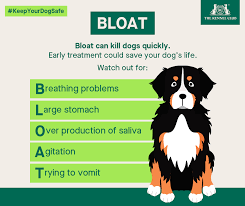 Dog bloat is a common condition that can be dangerous, even deadly. Dogs who have it need treatment right away. Know the signs so you can recognise when your pup needs help.
Dog bloat is a common condition that can be dangerous, even deadly. Dogs who have it need treatment right away. Know the signs so you can recognise when your pup needs help.
What Is Dog Bloat?
Bloat happens when a dog’s stomach fills with gas, food, or fluid, making it expand. The stomach puts pressure on other organs. It can cause dangerous problems, including:
- Decreased blood flow to their heart and stomach lining
- A tear in the wall of their stomach
- A harder time breathing
In some cases, the dog’s stomach will rotate or twist, a condition that vets call gastric dilatation volvulus (GSV). It traps blood in the stomach and blocks it from returning to the heart and other areas of the body. This can send your dog into shock.
Symptoms
Bloat from GSV usually comes on very quickly. At first, your dog may show signs that their stomach hurts. They may:
- Act restless
- Drool
- Have a swollen stomach
- Look anxious
- Look at their stomach
- Pace
- Try to vomit, but nothing comes up
- Stretch with their front half down and rear end up
As the condition gets worse, they may:
- Collapse
- Have pale gums
- Have a rapid heartbeat
- Be short of breath
- Feel weak
If you think your pet has bloat, get them to a veterinarian right away. If dogs don’t get treatment in time, the condition can kill them.
Causes
Vets aren’t sure what causes bloat, but there are some things that raise a dog’s risk for it, including:
- Eating from a raised food bowl
- Having one large meal a day
- Eating quickly
- A lot of running or playing after they eat
- Other dogs they are related to have had bloat
- Eating or drinking too much
- Stress
Any dog can have bloat, but it’s much more common in deep-chested, large breeds like Akitas, Boxers, Basset Hounds, and German Shepherds. Some are at a higher risk than others, including Great Danes, Gordon Setters, Irish Setters, Weimaraners, and St. Bernards.
Treatment
The treatment a dog gets depends on how severe their condition is.
First, the vet may put a tube into your dog’s throat and down to their stomach to release the pressure that has built up. Sometimes, a twisted stomach can keep the tube from passing through. If that’s the case, the vet may put a large, hollow needle through their belly into their stomach and release the pressure that way.
If your dog is in shock, the vet will start giving them fluids through an IV immediately, usually with antibiotics.
The vet will take X-rays to see if their stomach is twisted. If it is, your dog will have emergency surgery to untwist it and put it back in its normal position. The vet also will fix the stomach to prevent GSV in the future. They’ll also check to see if the condition damaged other parts of their body.
Prevention
Bloat can be scary, but there are ways you can keep it from happening to your dog:
- Don’t use a raised bowl unless your vet says your dog needs one.
- Don’t let them run or play a lot right before or after meals – ideally allow two hours between feeding and exercising.
- Feed them a few small meals throughout the day instead of one or two large ones.
- Make sure they drink a normal amount of water and never excessively.
- For predisposed breeds, your vet will sometimes tack the stomach when your dog gets spayed or neutered.
As always, I’m hoping this information is useful.
Many thanks for taking time out to read our latest blog!
SuPaw Nanny
